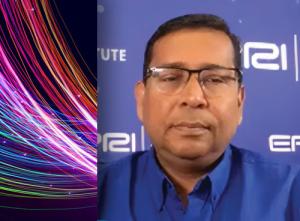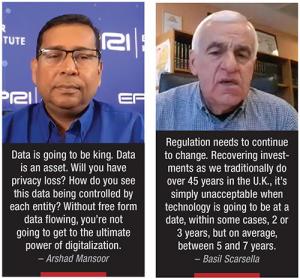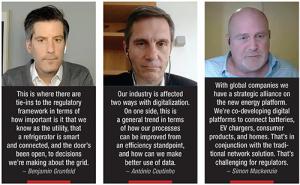Global Electrification Forum
Moderator Arshad Mansoor is CEO of the Electric Power Research Institute. Basil Scarsella is CEO of U.K. Power Networks. Simon Mackenzie is Group CEO at Vector. Benjamin Grunfeld is a Partner at Guidehouse. António Coutinho is CEO of EDP Innovation.
The growth of smart-grid infrastructure, decentralized generation, and improved data systems for grid maintenance represents the electric power sector's digital transformation. This digitalization trend has vast implications, with the internet of things, robotics, virtual and augmented reality, machine learning, and artificial intelligence redefining how the industry trains workers, operates the grid, and interacts with customers. At EEI's Fifth Annual Global Electrification Forum, Destination 2050, this panel focused on digital transformations in the electric power sector and its challenges.

Moderator and CEO, Electric Power Research Institute, Arshad Mansoor: When we look at that decarbonization and electrification pathway, which makes electricity more valuable for the society as the dependence on electricity grows, whether it's heating in the U.K., or electric transportation, how does digital technology play a role? It will continue to play a role. But what does this decade show us?
Basil at U.K. Power Networks, I've heard you talk about safety and customer service. How do you see digital technologies playing a role?
CEO, U.K. Power Networks, Basil Scarsella: U.K. Power Networks is the electricity distributor here in the U.K., in the London area, East and Southeast of England. In short, we deliver electricity to some 8.3 million domestic, industrial, and commercial consumers.
The focus for our organization is safety, customer service, reliability, and importantly, employee engagement. The networks are critical to the transition to low carbon. Unless we get safety right, we believe it's going to be difficult to get everything else to where we want it to be. We focus a lot on safety and customer service.

As the network and society becomes more digital, as we see customers interacting with their network more than ever, and working remotely, then safety and customer service become more critical.
We look at data as an asset, whether it's financial data, asset data, customer service, or customer data. You need to have accurate data, but if we fail to have the right technological skills, digital skills, and the right culture in the organization, there's always a risk that safety and customer service will suffer.
We see the digital transformation as an opportunity, but at the same time as a risk, because unless we get the right employees, and have the right employee commitment, then the safety and customer service we provide to 3.3 million customers is going to suffer. The focus we believe is right and continues to be increasing as we move more into a digital world.
Moderator and CEO, Electric Power Research Institute, Arshad Mansoor: Simon, how do you see broadband digital being part of the electric utilities' thinking and strategy?

Group CEO, Vector, Simon Mackenzie: At Vector, we provide all the electricity distribution networks across Auckland in New Zealand, the largest city. We have a portfolio of companies ranging from smart metering to gas trading, gas solutions, microgrid development, and operations across the Pacific.
We started our fiber journey about twenty years ago, where we were developing IP strategy across our network, and building that, we put out fiber to most of their connection points across the network.
Off the back of that, we identified the opportunity to provide those services to primarily major customers. This was not only the electricity distribution services, but also fiber connectivity to, in our case, primarily business customers, whether it's mobile operators, offshore carriers, or other Telco retailers.
We've expanded as we provide backup to a lot of cellular operators in New Zealand. We're seeing now 5G rollouts with collaboration about how the 5G rollout can work on the fiber network as well as hosting it on some of their assets.
We look at it as an integral part of our business. We're not a retailer. We provide what's called Layer 1, Layer 2 services. We're being integral to digitalization of our network but also part of our customer service proposition, which is critical in two ways. We're seeing that people are wanting options to the primary carrier here, which was previously Telecom New Zealand and is now Spark.
They have diversity of options and fiber, and what we're connecting a lot more to now are our investments and batteries across our network and other devices that need to be IP connectable.
Moderator and CEO, Electric Power Research Institute, Arshad Mansoor: Benjamin, give us some sense on the megatrends in the next five to ten years on digitalization as it relates to electric utilities. What are some projects Guidehouse will be on in digitalization with utilities?
Partner, Guidehouse, Benjamin Grunfeld: When we talk about trends in digitalization, we use the term digitalization to characterize it now and talk about a lot of things, but it goes back quite a way to the early smart grid initiatives in each of the countries that are represented here. We work with utilities in the Middle East, across Europe, in Canada, the U.S. and Asia. Everyone's at different stages of grid modernization.
These are the aspects of digitalization that are focused on the asset. We're taking what were analog devices on the grid and upgrading them to digital, making sure we have sensors and visualization capabilities built into the grid and into the infrastructure and upgrading the equipment, assets, and infrastructure.
That shifted with fiber rollout and fiber investments going back ten to twenty years, that shifted to communication infrastructure. That's the next trend in this evolution. We're starting with the asset, then focusing on communication backbones, being able for these assets now that we've got digital readouts and data being created in digital form from all these assets, then how do you get them to talk to each other? Also, how do you get them to talk back to the offices, back to the engineers, and back to the control room, in a way that's effective?
When we look at the trends, both of those still have a long way to go when we think about the power and utility sector. There's a lot of the grid that is largely analog, that's largely manually operated by power or gas. There's still a lot to happen in that space.
When we look forward, we're seeing the continuous evolution from assets and communication into data, but also the processes that are enabled off that data. How do we start to digitalize the function that the utilities carry out internally, or functions of asset system planning, or functions of customer service provision, or something as simple as bill payment which in some parts of the world you have to walk into a door with your bank check and pay your utility bills?
If you were to take a test overall of where the power sector is or where the utility sector is on its digitalization journey relative to other industries, we wouldn't score very well on the whole, I think. There's still a long way to go in terms of completing that transition to a digital industry.
Moderator and CEO, Electric Power Research Institute, Arshad Mansoor: António what do you see as some of the innovation opportunities and maybe challenges on digitalization?
CEO, EDP Innovation, António Coutinho: The energy transition is a challenge that takes digitalization as a key component. Our industry is affected two ways with digitalization. On one side, this is a general trend in terms of how our processes can be improved from an efficiency standpoint, and how can we make better use of data.
The world is going to be electrified, the world is going to be decentralized, and it's going to be renewable with all the intermittencies. We need to deliver electricity with the same level of reliability that we have today.
We are going to have to orchestrate a lot more assets, assets that we don't control in a way that delivers the power when we switch on and turn off the lights and the miracle continues to be there. The only way we can do this is through digital technologies. These are the changes that are fundamentally changing our industry.
Innovation is working the same way. One side is a key — traversal business trends. On the other side is going to be a key component of our industry because the energy transition is changing the way we generate and consume energy or power energy in thirty years, and we are going to redo everything that took a hundred and fifty years to get here.
It's more than technology. The technology to deliver the carbon neutrality exists today. What is different is, how do we make the change? How do we make all these investments? How do we enroll customers to manage their flexibility?
This decentralization of the industry creates a problem of the transactional ability of the industry that is going to increase. We need to increase the workforce to deliver all these goods, because as the industry gets distributive, it's more labor intensive.
How do we train these people? How do we acquire these people into this workforce? These are new areas, not just of digital, but also of innovation. We need to build new business models with these significant changes.
We recently made a strategic market update, where we pledged to invest twenty-four billion until 2025. We committed an investment of two billion in digital and innovation to bring the energy transition.
Moderator and CEO, Electric Power Research Institute, Arshad Mansoor: We know how to build an infrastructure that lasts for forty or sixty years, but we maintain them. That's a core competency. We're entering this world of digital where maybe ten years from now, twenty to thirty percent of our investment is on the digital side, with a different lifetime expectancy.
It's not going to last eighty years. The fundamental business phases, the regulatory process has to change on how you amortize that. As a network operator, Simon, and Basil, give some insight on how you see this future of utility going where we're investing in digital technologies, more so than in transformers, wires, and poles.
CEO, U.K. Power Networks, Basil Scarsella: You're right. We'll continue to build assets that last forty to sixty years, but there's going to be a number of assets and a lot of investment on new technologies and digital, which will last a lot shorter than we're used to for the traditional assets.
Regulation needs to continue to change. Recovering investments as we traditionally do now, over forty-five years in the U.K., it's simply unacceptable when technology is going to be at a date, within some cases, two or three years, but on average, between five and seven years.
In the U.K., we've moved on from a rate base regulation to an incentive-based regulation, which in short, we are incentivized to deliver the commitments we've made to the customers at the lowest possible cost, safely as always. At the same time, that enables us to earn incentives by over delivering the commitments in critical areas such as reliability, and customer service. There's a good example where the U.K. regulatory regime has evolved.
As we move forward, we've got distributed generation, decarbonization, and investment in technology. Regulation needs to continue to evolve. I'm confident that's happening as we speak. Whether regulation evolves as quickly as technology and as the energy system, that's going to be a challenge. But that's a challenge we all face and I'm sure the regulatory regime will continue to evolve.
Group CEO, Vector, Simon Mackenzie: Our focus has been around looking at digital technologies for quite a long time now. It's an integral part of our business. We start with how we manage our networks to what we call probabilistic AI. It's about using artificial intelligence connected to devices to grow better utilization from assets.
The regulators will look at, you can't continue to build in a deterministic mindset. Through significant amounts of data and machine learning, artificial intelligence, integrated into digital platforms, we are completely changing the way we think about the capital intensity of the business through augmenting traditional network management with those digital platforms. We're orchestrating a completely different way of running the system. What does this mean for us to achieve that?
We've collaborated with a number of global companies, and have a strategic alliance with AWS, for example, on what we call the new energy platform. We're co-developing digital platforms with Amazon, and we've built with Israeli company mPrest, platforms that we're utilizing to connect batteries, EV chargers, consumer products, and homes. That's all being orchestrated in conjunction with what we call the traditional network solution. That's challenging for regulators to be able to keep up with the trends.
We're starting with recognizing that customers want choice and options in orchestrating them primarily on digital platforms that bring together data analytics, customer choice, and connectivity to customers to make those choices.
For regulators one of the biggest challenges is, how they have the scope sets to understand what the capabilities of the digital platforms are, and what that means to the objective of providing reliable service, safety, and security to customers?
Moderator and CEO, Electric Power Research Institute, Arshad Mansoor: Data is going to be king. Data is an asset. Will you need free exchange of data so we can do a data driven decision making at an optimum level?
Will you have privacy loss? Will you have people thinking, if I'm a thermostat manufacturer, or a smart technology, I have access to the customer, and I have the data, but that data is essential to offer energy services, and to operate the grid.
How do you see this data being controlled by each entity? Without free form data flowing, you're not going to get to the ultimate power of digitalization.
Partner, Guidehouse, Benjamin Grunfeld: You need to think about the data in two ways. There's like a grid door, in front of the meter data that the utilities are generating, collecting, analyzing, and incorporating in their decision making and in the processes.
That has some different characteristics and challenges, then let's call it behind the meter or customer specific data, what comes out of a smart phone app that a customer signed up to, or what comes out of an automated smart home system or an energy management system that someone's installed in their building or in their household.
The power sector doesn't need to reinvent the wheel here. Look at the proliferation of information and data, and companies like Google or NASA, or companies in your home already that know more about you than you know about yourself.
It's being managed. There are privacy laws, and companies are generating that information. It is being protected in the sense that data that's collected by one company is used as a competitive advantage.
This is where there are tie-ins to the regulatory framework in terms of how important is it that we know as the utility, that a refrigerator is smart and connected, and the door's been open, to decisions we're making about the grid.
There are some things that need to be shared, need to be accessible, and we need to manage the privacy and protection around that. There's the competitive element of what happens in the home, what happens behind the meter that produces different outcomes.
It's creating innovation and driving innovation in that space. The utilities in the sector will find a way into that. There are ways to, generally speaking, protect customer information, personal identifiable information, the commercially sensitive information.



